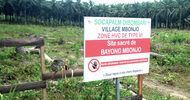Starbroek News | June 22, 2009
Guyana is still waiting for the large investment dollars in agriculture, as it takes steps to become a key producer in the region’s multi-billion dollar food industry.
Agriculture Minister Robert Persaud in a recent interview said that the “interest” in food security from the region “could be a bit … warmer.” The almost $4B food import bill the region faces is testimony to its huge market, where countries like Guyana, with its vast arable lands and the capacity for large-scale agriculture investment, can make huge sums for national development.
Persaud said he was sure that in “due course” the region will have a more positive response as increasingly there have been more exchanges and “that is encouraging.” However, critics have said the era of cheap food has come to an end as both developed and developing nations worldwide are looking at ways to avoid a food shortage crisis, in the light of the growing food demand and an energy sector that is encroaching on food crops, like corn.
The Region needs to collaborate and address constraints, Persaud said, explaining for example that Guyana can be the producer while a country such as Trinidad and Tobago can do the processing since it enjoys low energy costs. It had been posited that Guyana has the resources, once regional investors ‘have the investment dollar’. The Guyana government has also rolled out several invitations to regional investors that included land offers for agricultural purposes.
In the meantime, the minister said government is not putting all its eggs in one basket and will be actively seeking to boost exports to North and South America. Exporting non-traditional vegetables and fruits over the years has shown an upward trend and recently such exports have shown a 35% increase.
Food security in communities mixed
Guyana is a net exporter of food and generally enjoys a certain level of food security, but last year government embarked on a ‘Grow more food’ campaign aimed in-part at increasing food production and price stability, as global food prices had spiked. Since its launch, the minister said the response from the public has been “overwhelming.” He said too the ministry has tried to address shortcomings in areas where they have been found. Persaud said cultivation has increased in regions with an agriculture background but farmers in other regions have also been able to boost production though he believes that more can be done in the hinterland areas. Through the campaign, support has been given to improve infrastructure (drain-age and irrigation); establish demonstration farms; provide farming materials like seeds and market support to farmers so they can grow what the market demands (through the New Guyana Marketing Corporation). However, in places like the Berbice River although its agriculture potential is known, the extended flood periods have decimated many farms. The minister said the cost of a full scale drainage and irrigation system to prevent the flooding is “prohibitive,” but noted that interim measures can be taken. Intermediary ports have also been built in Region One and the staff at various agriculture stations has been boosted during the year to facilitating the growing food campaign and market access for farmers. The National Agricultural Research Institute branch in Lethem, Region Nine will be increasing collaboration with the Brazilian agriculture entity, EMBRAPA (Brazilian Agricultural Research Corporation) as that region seeks to take advantage of trade with Brazil. Persaud said too Linden farmers are primed to benefit from business in agriculture. “Linden should be a major supply point for food,” he said, “not only to supply Linden but create linkages” by exporting across the border and to miners. He remarked that Linden could be “a hub for food production for interim locations.” The minister said the community can become a “niche” area where job opportunities can be created but in order to maximise on this opportunity farmers would have to meet certain standards before their produce can cross the border.













